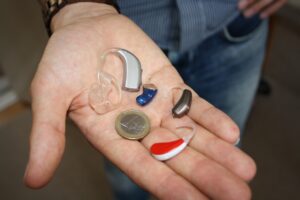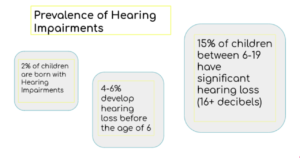

Our Video:
Pictures in the video are from www.freepiks.com
Data and Statistics About Hearing Loss in Children. (2020, June 08). Retrieved September 19, 2020, from https://www.cdc.gov/ncbddd/hearingloss/data.html
Schmucker, C., Kapp, P., Motschall, E., Loehler, J., & Meerpohl, J. J. (2019). Prevalence of hearing loss and use of hearing aids among children and adolescents in Germany: a systematic review. BMC public health, 19(1), 1277. https://doi-org.proxy.library.vanderbilt.edu/10.1186/s12889-019-7602-7
Background:
- IDEA definition: “[…] an impairment in hearing, whether permanent or fluctuating, that adversely affects a child’s education performance” (IDEA, 2004).

- There is high comorbidity of hearing impairments with other disabilities
Characteristics:
- Communication
- Developmental delay in producing speech sounds due to limited auditory input from a young age
- Less complex vocabulary compared to peers who are typically developing
- Literacy
- Difficulty with reading comprehension
- Developmental delay with complex written language, especially syntax.
Interventions:
- Communication
- Cochlear Implants
- Surgically implanted to bypass the damaged part of the auditory system and allows sound to communicate directly with the brain
- Almost 80% of people who are congenitally deaf use cochlear implants
- Cochlear Implants
- Literacy
- Self-Regulated Strategy Development (SRSD)
- A strategy implemented to specifically target writing deficits that teaches drafting, creating, and editing samples of writing and incorporates motivation into the learning process.
- Self-Regulated Strategy Development (SRSD)

Resources for Parents:
Resources for Teachers:
- https://deafchildren.org/wp-content/uploads/2014/03/Deaf_Friendly_
- https://deafchildren.org/wp-content/uploads/2014/03/Deaf_Friendly_Classroom.pdf
- This PDF gives a list of tips for parents to use when sending their child to school to determine if the classroom setting is adequate for their child’s needs.
Pictures from:
https://www.freepik.com
